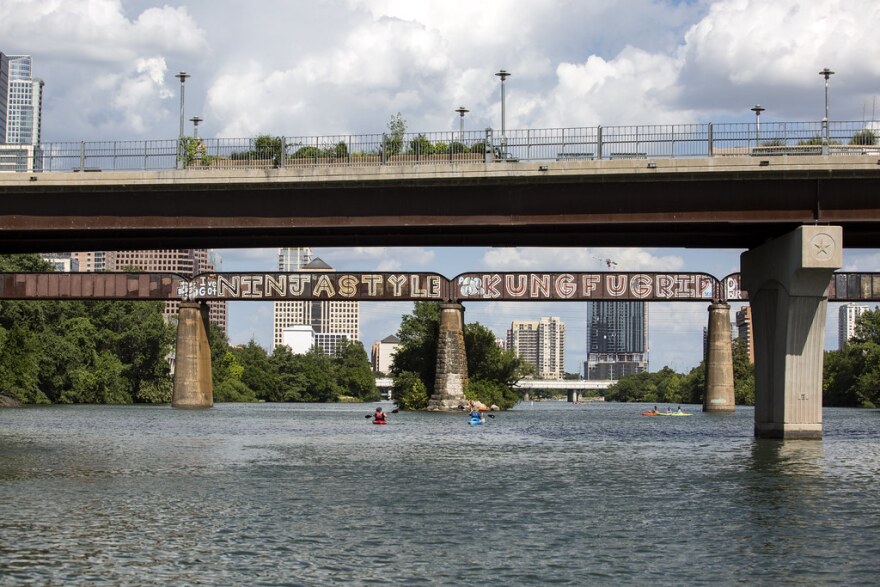This story was originally published December 16, 2020.
This is a story about trying to inspire strangers – and committing some crimes to do it.
On the train bridge that goes across Lady Bird Lake, just east of Lamar, there's some graffiti. Some of it is your average garbage, but other pieces stand out.
There’s one piece that says in huge letters, “I’ve Got Ninja Style And A Kung Fu Grip.” There’s another piece with Pac-Man being chased by four ghosts that says “Never Give Up." They’re big – yes – but they’re not particularly detailed or anything. They stand out mostly because they’re kind of inspirational, not just some random tag from someone trying to promote their brand.
This is art that gives this place a bigger meaning. And that’s why Melisa Hinojosa was so curious about it.

“I’ve taken countless pictures here in front of this scene,” she says, standing on the pedestrian bridge over the lake just to the west of the train bridge. She even took her wedding photos here.
But something bugs her. How did the artist do this? The bridge – which trains go over fairly regularly – is 40 or 50 feet over the water. Getting out there and staying out there for hours to paint sounds really difficult and really dangerous.
“Did he do it upside down? I have no idea,” she says.
And maybe more importantly: Why did this person do it?
I started to look into this question after Hinojosa asked it in 2016, but it took nearly four years to finally get the answer. I worked really hard to uncover it, so keep reading.
Thanks, Universe
Actually, I didn’t have to work that hard. In fact, it was one of those things where the universe just kind of clears a path for you and all you have to do is follow it.
The graffiti does include the artist's initials: S.K.O. I couldn’t find any other graffiti signed like this. Googling turned up nothing. But then, a few weeks after Hinojosa asked the question, I got a message from a guy named Patrick Reetz. He had no idea I was looking for the person who painted on the bridge. Out of nowhere, he says: “Hey, if you ever want the story on the train bridge graffiti, I know who did it.”
He said it was his old roommate, an Army soldier stationed overseas at the time.
RELATED | Subscribe to the ATXplained podcast
I asked Reetz to connect us. A few weeks went by, and I got an email from “John St. John.” This was a fake name, of course, because the alleged artist wasn’t sure he wanted to use his real one. Of course, I was skeptical at first. Was this just some dude trying to claim credit for perhaps the greatest artistic crime in Austin?
We exchanged emails, but then he'd disappear for weeks or months without replying. After about a year of this, he vanished. I thought maybe he got bored and didn’t want to keep lying to me.
It was another year and half before I heard from him again.
“Hello again,” he wrote. “:)”
'I Have To Paint It'
In February, we finally did a real interview. Scott Kimble O’Donnell is his name – S.K.O., just like the initials on the bridge.
O’Donnell, 49, is a sergeant in the U.S. Army now, stationed in El Paso. He moved to Austin in 2008, just before the first of the bridge pieces went up.

“I think I went running around Town Lake and it was just covered in s- - - graffiti,” he recalls of his first time seeing the bridge. “I remember looking at it and thinking, ‘Well, if other people can get up there and paint, I could do it. I could paint it better.’”
O’Donnell was always drawing as a kid. He later went through a phase where he’d build these giant papier-mache sculptures, but he never really had any idea what he was doing.
“I’d just think of something I want to do, and I just sit down to figure out how to do it,” he says. “And it's probably not the best way or the way that other people have done it. But, you know, through trial and error, I kind of made it work.”
O’Donnell had never done graffiti before, but when he saw the bridge for the first time, he just knew.
“’I have to paint it.’ It was like I was drawn to it almost," he says.
It was sitting there, waiting to be painted, a canvas for the whole world to see.
Focus One Point And Breathe
One night, dressed all in black, he headed out to the bridge with a long stick, a paint roller, a paint tray and some paint. He walked out on the train bridge a little ways, climbed up on the metal wall and perched himself on the edge, looking down into the water.
Awkwardly, he tried to paint a canvas on the side of the bridge, but he quickly realized that was not going to work.
But O’Donnell had a Plan B.
“If I'm going to do this right, I'm going to have to climb out here,” he says. “I was like, ‘All right, let me figure out how to climb.’”
He headed off to REI to buy some gear.
“I knew this was illegal and I didn't want someone to rat me out to the police,” he says. “So I sounded very vague about … what I wanted to climb. But they sold me a harness and some rope and told me how to make certain knots.”
A few days later, O’Donnell headed back to the bridge. Dressed all in black. Climbing gear in hand, backpack full of spray paint. He tied off the rope and went up on the edge. He was ready to go over.
“It's scary. Like heart-poundingly scary because you have to throw your legs over the side," he says, describing how he was lying on his belly with his feet hanging over, inching his way down. "You really have to learn to trust your equipment.”
He painted a little something on the bridge that night, but when he went back to look at it the next day, he realized how small it was. He needed to go BIG.
This was his first big one.

It didn’t last long. A few weeks later, the whole bridge was painted over.
“But whoever was on the paint crew left behind the sign that said ‘Focus One Point And Breathe.’ They painted over everything, but that," O'Donnell says.
So he said to himself: “This is a sign. All right, I'm coming back.”
Life Is Change, Be Flexible
The next piece was a nod to the bridge getting painted over.
"Life is change, be flexible,” he painted, with a yin-yang symbol and a koi fish next to it.

He also repainted the parts of Focus One Point And Breathe that were erased.
The murals took about two weeks each. O'Donnell would go out for a night, take a few days off, then come back and paint some more.
“I was always aware of the audience," he says. "I knew people were going to see this because hundreds of people go by the pedestrian bridge a day, so I wanted to put something up there to like, inspire or just to like, help someone."
But on his next piece, he ran into some trouble.
The Robot
“I like doing the dance, the Robot. Like, pretend you're a robot," O'Donnell says. "So, I thought it'd just be fun to put it up there: Pretend you're a robot.”
So back he went. He painted the words “Let’s Pretend We Are Robots.” Then a robot. And then he started to paint another robot.

Halfway through, a train came by. He was hanging off the bridge from his rope, kind of leaning back to watch the train pass. Then O'Donnell sees the conductor. The conductor sees him.
“Next thing I know, there’s flashlights and I’m being taken to the Travis County holding cell,” he says.
The police charged him with felony graffiti.
This is a problem, and not just because he’s in jail. O'Donnell had joined the Army and was supposed to ship off to basic training in a few weeks. A felony charge was going to complicate things.
He posted bail and called a lawyer. The charges were dropped in exchange for O'Donnell paying a few thousand dollars in restitution.
I asked if this made him reconsider whether it was worth it anymore.
“No, no. You know why? Because probably like maybe a year and a half year later, the railroad company came and painted over everything. The bridge was wiped clean," he says. "So, I literally I flew back and painted more."
That's when he painted the Pac-Man scene with the words “Never Give Up.”

On the one hand, O'Donnell says, he meant it as an inspirational message.
“Whatever you're going through, don't give up. If you’re exercising, don't give up. If you're suicidal, don't give up," he says. "You know, just don't give up."
But for him it was also a message to Union Pacific, "like, I'm not giving up.”`
About a year later, he came back to do the Ninja Style one.

And what does that one mean to him?
“I’m like a ninja; I move in the night. Because I’m hanging out here, I gotta hang on like super-tight. A kung fu grip is a strong grip, right? And it just kinda sounds cool,” he says.
But it can mean something else to the audience.
“Like that’s what I gotta do every day … gotta put on ninja style," Hinojosa says. "You have to figure it out and work through your day … and have a kung fu grip doing it."
O'Donnell's last two pieces – Ninja Style and the Never Give Up Pac-Man – are still there. In a place that seems like it’s constantly changing, they’ve stayed constant – for now anyway.
“I think that it’s a part of just what it means to live in Austin,” Hinojosa says. “We have this motivating messaging done by a random stranger that just motivates thousands of people every day.”
Focus One Point (Again)
When I talked to O'Donnell that first time, he hadn’t been back to Austin since he painted Ninja Style in 2012. By chance, he happened to be here for Thanksgiving, so we met on the pedestrian bridge, and I asked him how it felt to see his work still up after eight years.

“It makes me joyful. Giddy. Just happy to see that it’s still here,” he says. “Like just to see this and know that I’m affecting the community. … It’s part of their life now. Something that I made is in there. And to know that people are getting something from it is really – wow – just really exciting.”
O'Donnell knows it won’t last forever, but he’s OK with that.
“I don’t like it that it’s going to go away, but I accept that it will change," he says. "And this is also another opportunity to come back up and do something else.”
Under state law, O'Donnell can't be charged for painting Ninja Style and Never Give Up because too much time has passed.
He's still doing art. Right now he’s making collages out of dots made from paint color samples and a hole punch.
And you might have noticed that a new version of his Focus One Point And Breathe piece went up on the train bridge last month. It looks good – but that’s all I’m going to say about that.

_











